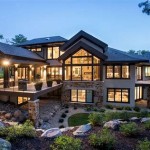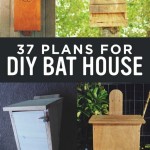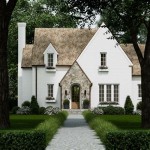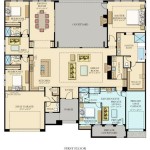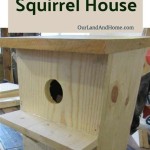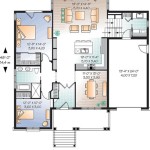Guest house floor plans are blueprints that outline the layout and design of self-contained accommodations typically built on the same property as a primary residence. These structures provide additional living space for guests, extended family members, or as a rental income source. Guest houses often feature a bedroom, bathroom, living area, and kitchenette, offering privacy and convenience for occupants.
When conceptualizing guest house floor plans, factors such as the size of the property, desired amenities, and budget constraints must be carefully considered. Architects and designers collaborate with homeowners to create customized floor plans that seamlessly integrate with the main house while maintaining their own distinct character and functionality. The result is a harmonious and cohesive living environment that caters to both the needs of the homeowner and their guests.
In the following sections, we will delve deeper into the intricacies of guest house floor plans, exploring various design options, space planning strategies, and construction considerations to help you create the perfect guest house for your property.
When planning a guest house, consider these crucial elements for a functional and inviting space:
- Determine size and layout
- Consider amenities and features
- Plan for privacy and accessibility
- Integrate with main house design
- Optimize space with smart storage
- Maximize natural light and ventilation
- Select durable and low-maintenance materials
- Comply with building codes and regulations
- Stay within budget constraints
- Consider future expansion or changes
By incorporating these key points into your guest house floor plan, you can create a comfortable and welcoming space that complements your property and provides a memorable experience for guests.
Determine size and layout
Determining the size and layout of your guest house is a crucial step in the planning process. Consider the following factors:
Number of guests: Estimate the maximum number of guests you anticipate accommodating. This will influence the size of the bedrooms, bathrooms, and living areas.
Amenities and features: Decide on the amenities you want to include in your guest house, such as a kitchen, laundry facilities, or a separate living room. These features will impact the overall size and layout.
Privacy and accessibility: Plan for privacy by ensuring the guest house has its own entrance and outdoor space. Consider accessibility features for guests with disabilities or limited mobility.
Integration with main house design: The guest house should complement the main house in terms of architectural style and exterior finishes. Consider the placement of the guest house on the property for optimal privacy and convenience.
Future expansion or changes: Think ahead about potential future needs or changes. Consider designing the guest house with flexibility in mind to accommodate future expansion or modifications.
Consider amenities and features
When planning the amenities and features of your guest house, consider the following:
Kitchen: If you plan on guests cooking meals, a kitchen is essential. Decide on the size and layout of the kitchen, and include appliances such as a stove, oven, refrigerator, and sink. Consider adding a dishwasher for convenience.
Laundry facilities: A washer and dryer can be a valuable amenity for guests staying for extended periods. Consider placing the laundry facilities in a dedicated laundry room or utility closet.
Separate living room: If you want guests to have their own private space to relax, consider adding a separate living room to the guest house. This can be a cozy space with comfortable seating, a TV, and access to natural light.
Outdoor space: A private outdoor space, such as a patio or deck, can enhance the guest experience. Consider providing seating and shade for guests to enjoy the outdoors.
Plan for privacy and accessibility
When planning your guest house floor plan, it is essential to consider privacy and accessibility for both guests and homeowners.
- Separate entrance: Provide a dedicated entrance for the guest house to ensure privacy for both guests and homeowners. This entrance should be separate from the main house entrance and lead directly into the guest house.
- Private outdoor space: Create a private outdoor space for guests to enjoy, such as a patio or deck. This space should be screened or fenced for privacy and have comfortable seating and shade.
- Accessible design: Consider accessibility features for guests with disabilities or limited mobility. This may include wider doorways, ramps, and grab bars in the bathroom.
- Soundproofing: Use soundproofing materials in the walls and floors between the guest house and the main house to minimize noise transmission and ensure privacy for both parties.
By incorporating these privacy and accessibility considerations into your guest house floor plan, you can create a comfortable and welcoming space for your guests while maintaining the privacy and comfort of your main residence.
Integrate with main house design
To ensure a cohesive and harmonious property, it is essential to integrate the guest house design with the main house. Consider the following aspects:
- Architectural style: The guest house should complement the architectural style of the main house. This includes elements such as the roofline, exterior finishes, and overall form.
- Materials and finishes: Use similar materials and finishes for both the guest house and the main house to create a unified look. This can include siding, roofing, and trim.
- Landscaping: Integrate the landscaping around the guest house with the overall landscaping of the property. Create a cohesive flow of plants, walkways, and outdoor spaces.
- Placement on the property: Carefully consider the placement of the guest house on the property. It should be close enough to the main house for convenience but far enough away to provide privacy for both parties.
By integrating the guest house design with the main house, you can create a visually appealing and functional property that enhances the overall value and enjoyment of your home.
Optimize space with smart storage
In a guest house, maximizing space is crucial to ensure a comfortable and functional living environment. Smart storage solutions can help you make the most of every nook and cranny, allowing you to accommodate guests without sacrificing comfort or style.
Built-in storage: Utilize built-in storage options such as shelves, drawers, and cabinets to maximize vertical space. Built-in storage can be customized to fit specific needs and can be incorporated into walls, under beds, or in awkward corners.
Multi-purpose furniture: Choose furniture that serves multiple functions to save space. For example, an ottoman with built-in storage can provide both seating and extra storage for blankets, pillows, or other items. A coffee table with drawers can offer additional storage for books, magazines, or games.
Vertical storage: Utilize vertical space by installing floating shelves, stackable bins, or hanging organizers. Vertical storage is ideal for storing items that are used less frequently or need to be kept out of the way.
Underutilized spaces: Make use of underutilized spaces such as the area under the bed or the space above the closet. Consider adding under-bed storage containers or installing shelves above the closet to maximize storage capacity.
Maximize natural light and ventilation
Incorporating natural light and ventilation into your guest house floor plan is crucial for creating a healthy, comfortable, and inviting living environment.
Windows and skylights: Ample windows and skylights allow natural light to flood into the guest house, reducing the need for artificial lighting and creating a brighter, more cheerful atmosphere. Position windows strategically to capture views of the surrounding landscape and maximize daylighting throughout the day.
Cross-ventilation: Cross-ventilation is the movement of air through openings on opposite sides of a room. It helps to circulate fresh air, remove stale air, and regulate temperature. Design your guest house floor plan to facilitate cross-ventilation by placing windows and doors on opposite walls or by incorporating clerestory windows or transoms.
Passive solar design: Passive solar design techniques can help to maximize solar heat gain in winter and minimize it in summer. Consider orienting the guest house to face south to capture the most sunlight. Use overhangs or awnings to shade windows from the high summer sun while allowing low winter sunlight to penetrate.
Building materials and finishes: The choice of building materials and finishes can also impact natural light and ventilation. Light-colored materials and finishes reflect light, making spaces feel brighter and more spacious. Use reflective materials such as white paint or light-colored tiles to enhance the natural light in your guest house.
Select durable and low-maintenance materials
When selecting materials for your guest house floor plan, durability and low maintenance should be key considerations. Durable materials can withstand wear and tear, ensuring the longevity of your guest house, while low-maintenance materials minimize the need for repairs and upkeep.
Flooring: Choose flooring materials that are durable, easy to clean, and resistant to moisture. Consider options such as tile, laminate, or luxury vinyl plank (LVP). These materials are highly durable and can withstand the foot traffic and potential spills that come with guest use.
Countertops: Opt for countertops made from durable materials such as granite, quartz, or solid surface. These materials are resistant to scratches, stains, and heat, making them ideal for kitchens and bathrooms.
Cabinets: Choose cabinets made from moisture-resistant materials such as solid wood, laminate, or thermofoil. These materials can withstand humidity and prevent warping or damage over time.
Exterior finishes: For the exterior of your guest house, select materials that are durable and require minimal maintenance. Consider options such as fiber cement siding, brick, or stone veneer. These materials are resistant to weather damage, insects, and fading.
Comply with building codes and regulations
To ensure the safety and habitability of your guest house, it is essential to comply with all applicable building codes and regulations. These codes and regulations are established to safeguard the health, safety, and welfare of occupants and the general public.
- Zoning regulations: Zoning regulations determine the permitted uses of land and buildings within a specific area. Before constructing a guest house, verify that your property is zoned to allow for such a structure.
- Building codes: Building codes specify minimum standards for the design, construction, and alteration of buildings. These codes cover aspects such as structural integrity, fire safety, accessibility, and energy efficiency. Adhering to building codes ensures that your guest house meets the required safety and performance standards.
- Fire codes: Fire codes regulate measures to prevent and mitigate the spread of fire in buildings. These codes specify requirements for fire-resistant materials, smoke detectors, fire extinguishers, and emergency exits. Compliance with fire codes is crucial for the safety of occupants in the event of a fire.
- Accessibility codes: Accessibility codes ensure that buildings are accessible to individuals with disabilities. These codes specify requirements for ramps, elevators, accessible bathrooms, and other features that facilitate access and use of buildings for all.
By complying with building codes and regulations, you can ensure that your guest house is safe, habitable, and meets the minimum standards required by law. Failure to comply with these codes and regulations can result in fines, construction delays, or even legal action.
Stay within budget constraints
Staying within budget constraints is crucial when planning a guest house floor plan. Here are some strategies to help you achieve this:
- Determine your budget: Before you start designing your guest house, determine your budget and stick to it. Consider the cost of materials, labor, permits, and any additional features you may want to include.
- Prioritize your needs: Decide which features are essential for your guest house and which ones are less important. Focus on incorporating the essentials within your budget, and consider adding additional features later if funds allow.
- Explore cost-saving options: Look for ways to save money on materials and labor. Consider using recycled or reclaimed materials, purchasing items during sales, or negotiating with contractors for better rates.
- Consider a smaller size: The size of your guest house will significantly impact the cost. Consider designing a smaller guest house that meets your essential needs while staying within your budget.
By carefully planning and prioritizing your needs, you can create a guest house floor plan that meets your requirements without breaking the bank.
Consider future expansion or changes
When designing your guest house floor plan, it is wise to consider the potential for future expansion or changes. This foresight can save you time, money, and hassle in the long run.
Plan for flexibility: Design your guest house with flexibility in mind. Avoid creating a rigid layout that cannot be easily modified in the future. Consider using modular components, such as movable walls or prefabricated units, that can be added or rearranged as needed.
Leave room for expansion: If you anticipate the need for future expansion, allocate space on your property for potential additions. This may involve leaving extra space around the guest house or designing the structure with the ability to add on additional rooms or wings.
Consider multi-purpose spaces: Incorporating multi-purpose spaces into your guest house design can provide flexibility for future changes. For example, a room that serves as a guest bedroom could also be used as an office or a playroom.
By considering future expansion or changes in your guest house floor plan, you can create a space that adapts to your evolving needs and provides lasting value for years to come.










Related Posts

